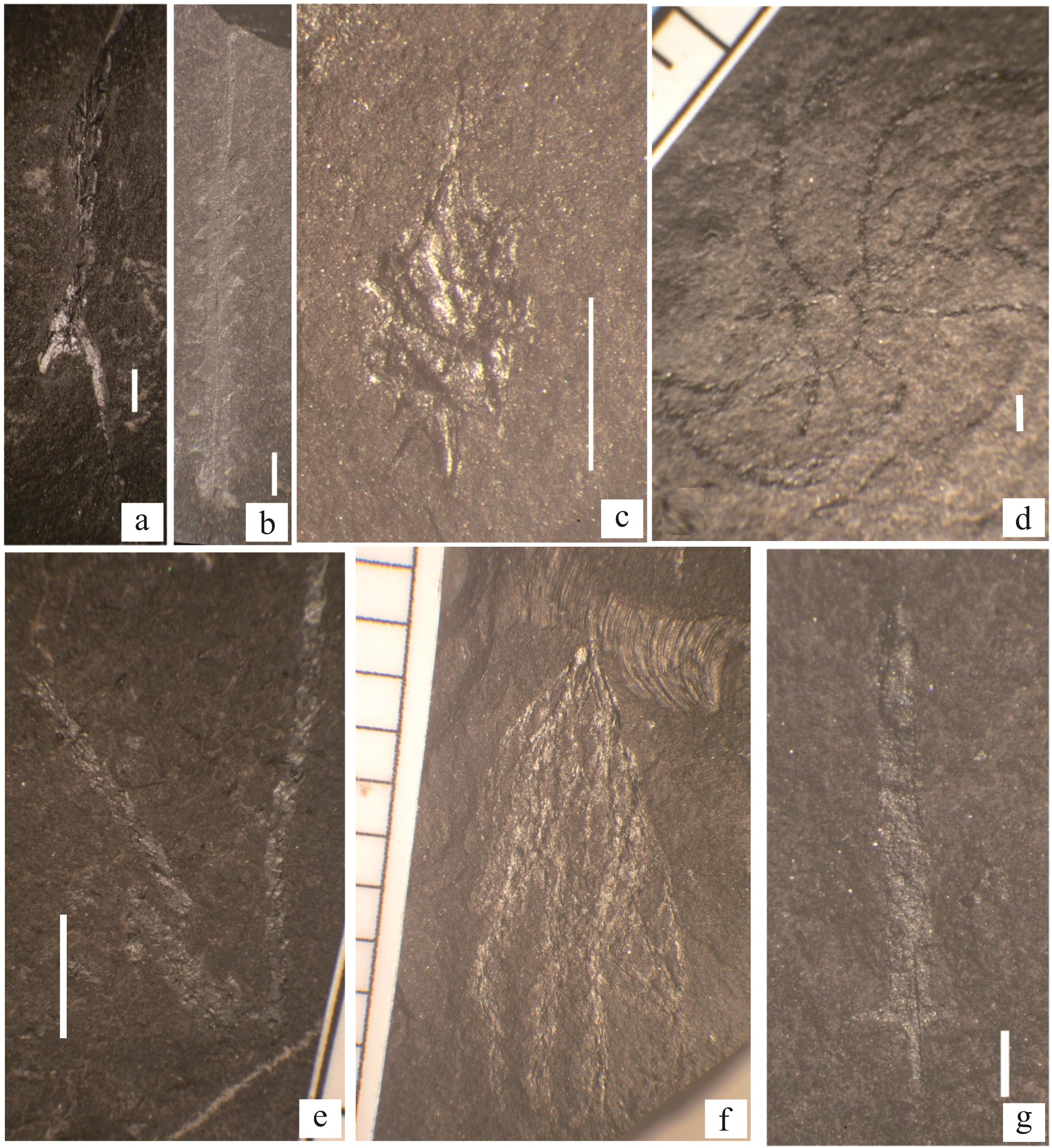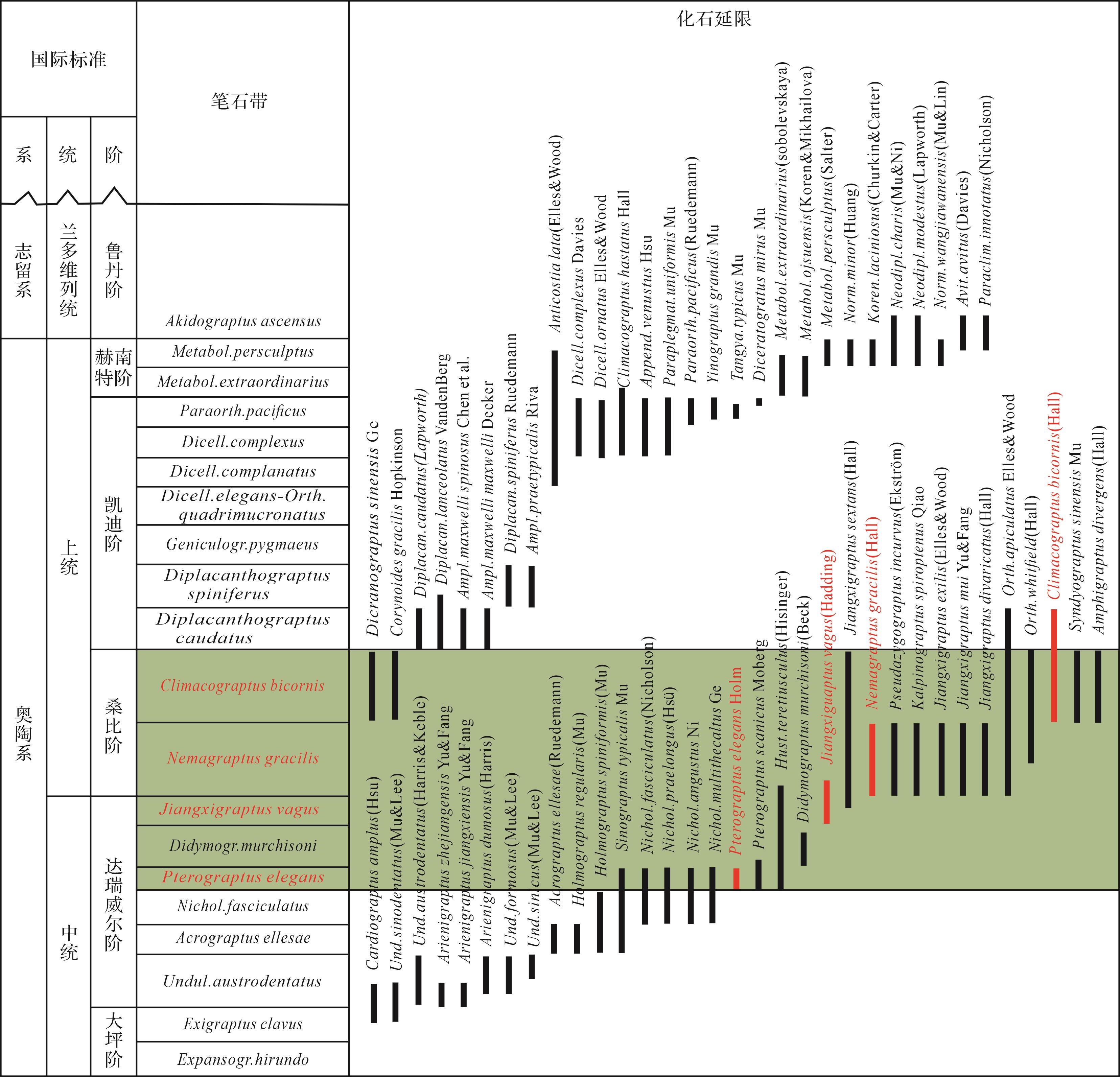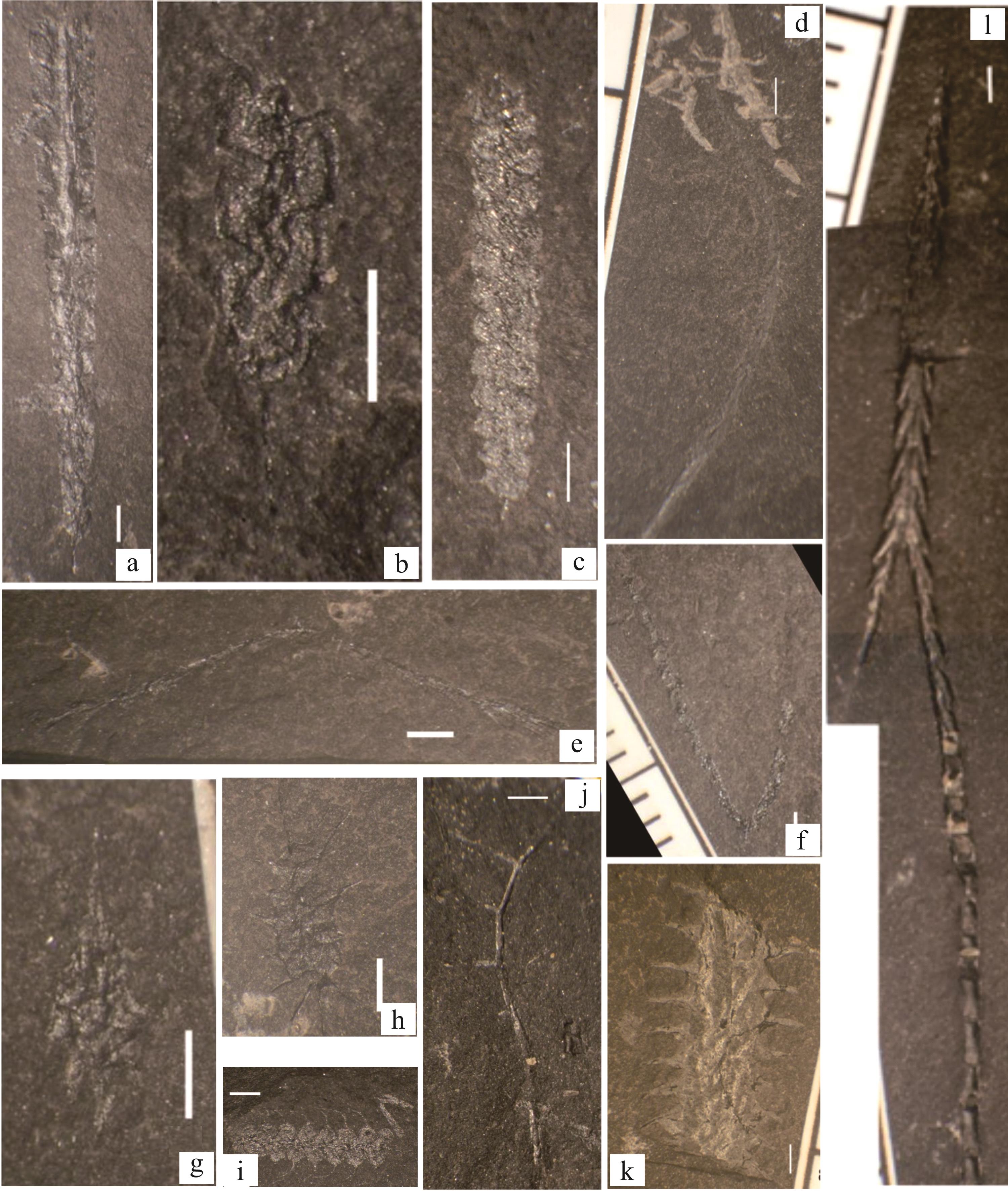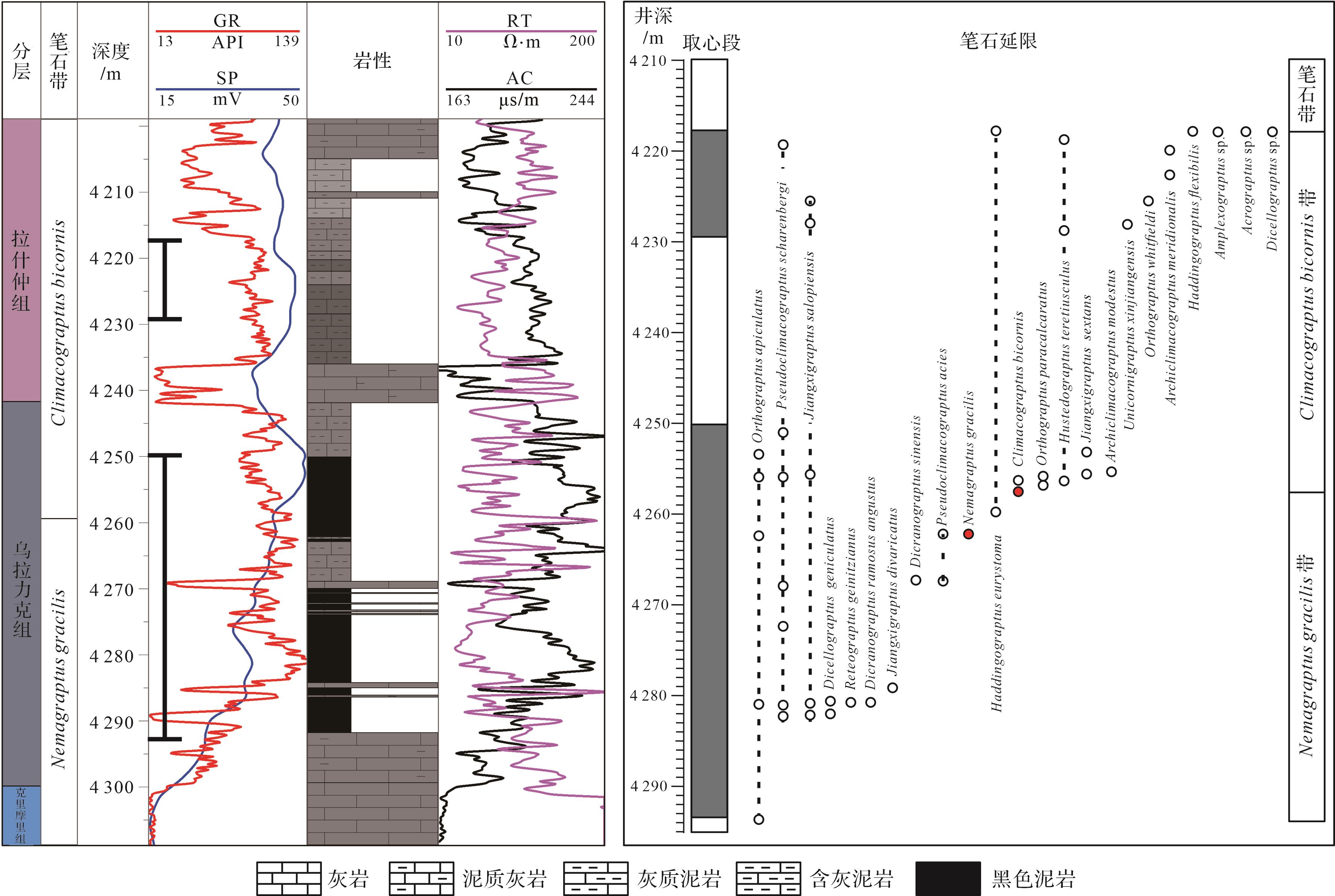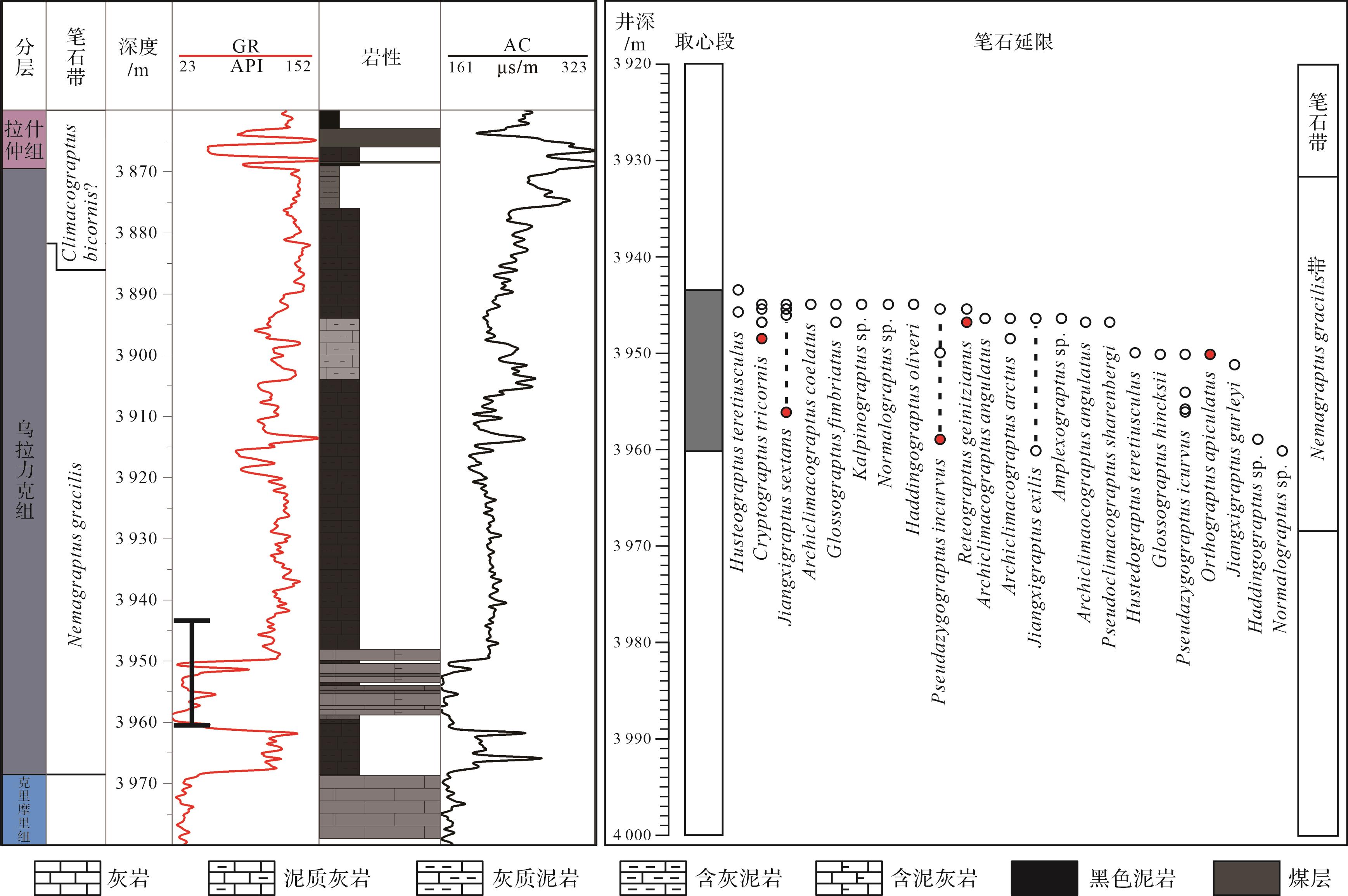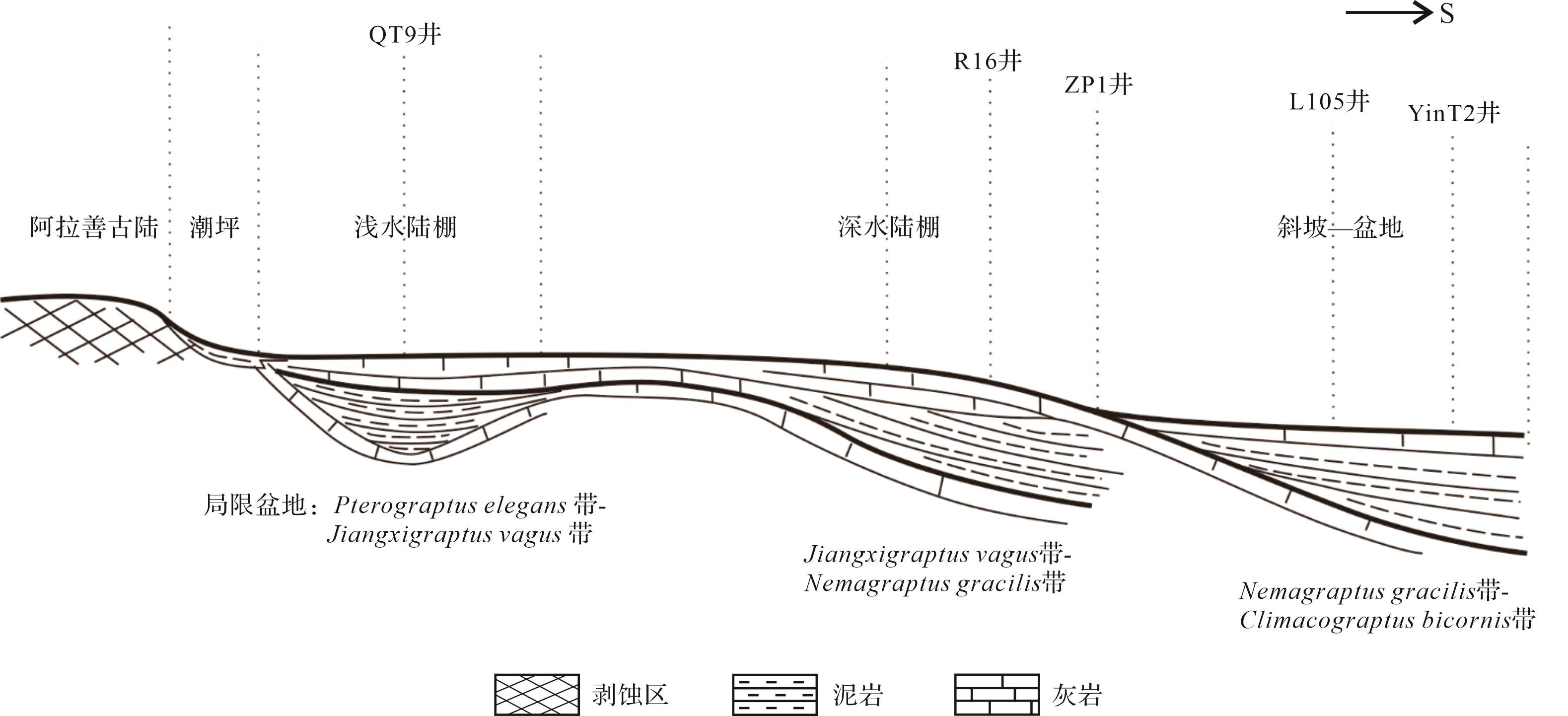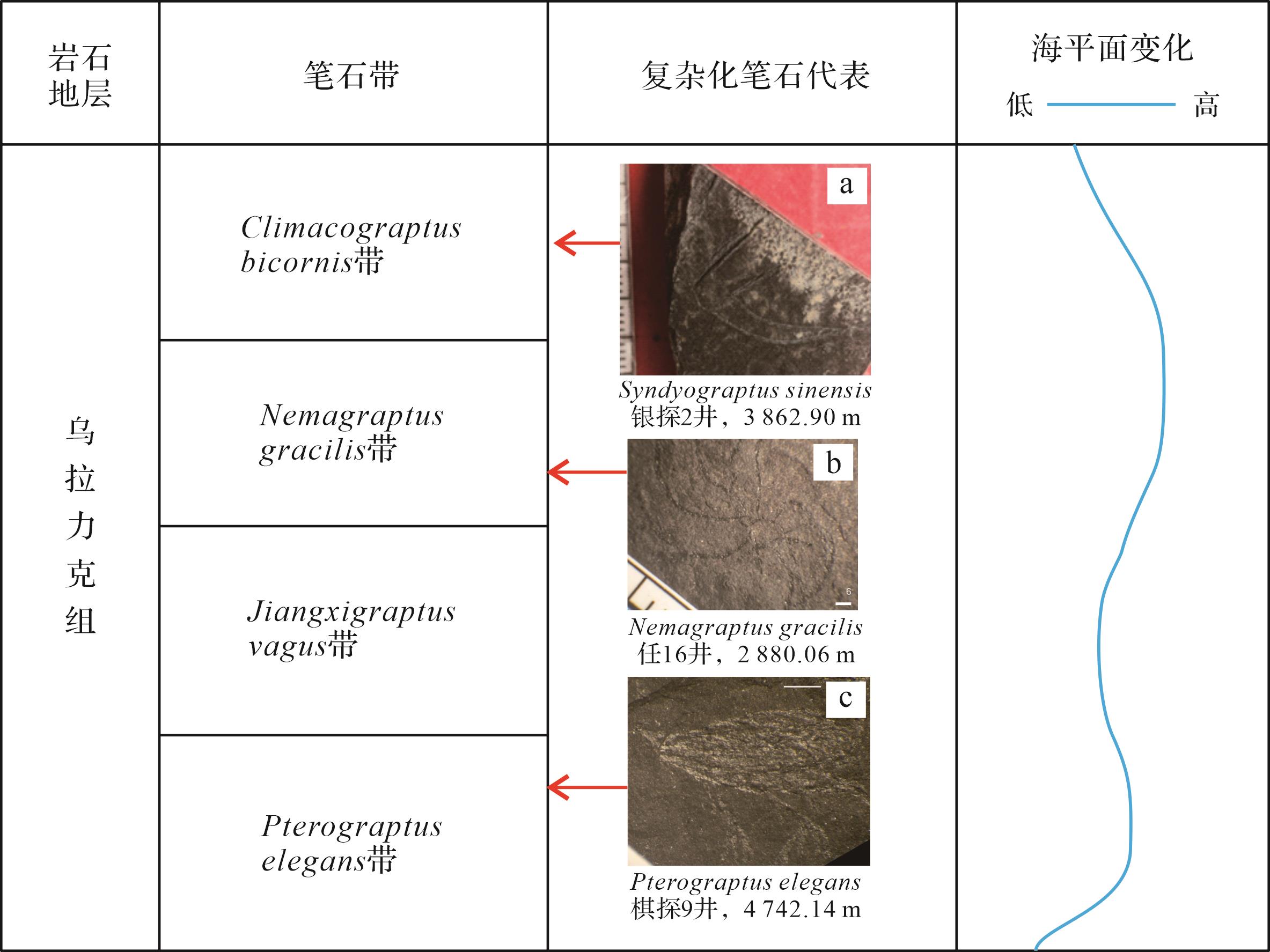HTML
-
中奥陶世乌拉力克组笔石泥页岩层是近年来鄂尔多斯盆地西缘海相页岩气勘探的主要目的层。长庆油田在鄂尔多斯盆地西缘奥陶系中不断发现天然气显示,忠4井在乌拉力克组试气获得4×104 m3/d的工业气流,证明盆地西缘乌拉力克组发育有效海相烃源岩[1⁃2],但目前对其地层及沉积环境演化特征认识不足,制约着勘探进展。
笔石是一类生活在古代海洋中的动物,其命名最早由瑞典分类学家林奈于1735年创立的类化石属“Graptolithus”演变而来[3]。笔石种类多、分布广、演化快、特征明显,被誉为奥陶纪、志留纪和泥盆纪早期地层研究的标准化石。笔石动物每隔几十万年就会产生新物种,且笔石的分布规律与沉积环境息息相关[4⁃5]。前人通过分析笔石化石发育特征及组合样式,在不同地区笔石特征建立了多种笔石带划分方案,进而分析地层的发育特征,明确沉积演化规律。张娣等[5]通过分析扬子西南缘五峰组—龙马溪组露头和钻井取心的笔石特征,建立等时地层格架,探讨笔石带的分布与沉积环境,明确优质页岩的发育特征及演化规律;梁峰等[6]通过分析川南地区五峰组—龙马溪组页岩笔石特征,建立了8个笔石带,认为黑色页岩的沉积时间与沉积速率在不同区块存在显著差异,黑色页岩沉积中心不断向北迁移;白灵麒等[7]通过鉴定内蒙古苏尼特左旗北部巴彦呼舒组的笔石化石,认为该组地层时代为中—晚奥陶世,发育于近源大陆斜坡沉积环境。
自20世纪80年代以来,前人对于鄂尔多斯盆地西缘乌拉力克组的笔石带及时代归属问题开展了较多研究,但仍存在较大争议。例如:傅力浦等[8]、马占荣等[9]通过对比岩性及上下地层笔石特征,将鄂尔多斯桌子山地区的乌拉力克组划为Glyptograptus teretiusculus与Nemagraptus gracilis 2个笔石带;张文华等[10]认为乌拉力克组最多包含Nemagraptus gracilis带底部;孙肇才等[11]将乌拉力克组限定在Glyptograptus teretiusculus带,将该组对应于达瑞威尔阶最上部。由于前人研究仅局限在剖面露头,缺乏钻井取心资料,致使对鄂尔多斯盆地西缘乌拉力克组的笔石特征认识不足,导致地层划分及其发育模式尚不明确。另外,前人认为乌拉力克组为镶边台地沉积模式[12⁃13],但未对其演化过程进行研究。
本文通过对鄂尔多斯盆地西缘乌拉力克组6口取心井的笔石进行鉴定,明确乌拉力克组时代归属,进一步划分研究区的笔石带,分析地层发育特征,建立生物地层格架,并在此基础上结合岩性特征讨论乌拉力克组的沉积演化规律,旨在为下一步油气勘探开发奠定基础。
-
鄂尔多斯盆地西缘处于鄂尔多斯盆地东、西部构造交汇区,整体呈南北向展布(图1a),在早古生代,盆地西缘位于鄂尔多斯地块与古秦岭洋之间,具被动大陆边缘性质[14⁃15]。受加里东运动与全球海平面变化的影响,在中晚奥陶世,其东部与华北地台接壤,西部延伸至贺兰海槽,也是祁连海所影响到的最东部[9]。在中奥陶世克里摩里期,海侵范围达到最大[16],至乌拉力克组沉积时期,西缘地区继续裂陷,东部继续抬升,由东向西依次发育浅水灰质斜坡、深水陆棚和海槽等相带[12](图1b)。晚奥陶世,海水向西南方向海退,致使西缘地区海相沉积结束[17]。

Figure 1. (a) Location of study area; (b) paleogeographic distribution map (modified from reference [12])
研究区奥陶系中—上统依次发育三道坎组、桌子山组、克里摩里组、乌拉力克组与拉什仲组[9](图2),奥陶系与上覆、下伏地层均呈不整合接触[15,18],其中乌拉力克组发育大量的笔石化石,为笔石地层划分的研究奠定了较好的基础。本文通过笔石鉴定,在前人研究的基础上[19⁃20]进一步理清了乌拉力克组的笔石带特征及层位归属,认为乌拉力克组属于中晚奥陶世达瑞威尔阶—桑比阶(图2),其自下而上发育Pterograptus elegans带(精美翼笔石带)、Jiangxigraptus vagus带(蜿蜒江西笔石带)、Nemagraptus gracilis带(纤细丝笔石带)、Climacograptus bicornis带(双刺栅笔石带)。
-
乌拉力克组系指克里摩里组石灰岩之上的一套以深灰色、灰黑色含笔石泥页岩,中夹数层灰色—深灰色泥质灰岩、灰岩的地层,其顶部泥页岩与拉什仲组底部石灰岩为界。目前对该套层系地层发育及演化模式没有清晰的认识,制约着页岩气勘探开发的进程。本文通过分析钻井岩心的笔石发育特征,建立笔石生物地层格架,分析地层及沉积演化规律。
-
通过对研究区E102井、E103井、L105井、QT9井、R16井、YinT2井、QT12井的取心段进行连续取样,根据笔石分枝情况、笔石枝生长方向、笔石始端与胞管的发育情况对研究区笔石的种属进行鉴定,明确笔石化石的垂向发育特征。研究区共识别出桑比阶两个笔石带和达瑞威尔阶上部的两个笔石带,共计笔石28属47种(表1)。
笔石带 属种 笔石带中所含化石包括 主要钻井 Climacograptus bicornis带 17属23种 Dicellograptus angulatus、Dicellograptus pumilus、Dicellograptus sp.、Unicornigraptus xinjiangensis、Didymograptus sp.、Archiclimacograptus arctus、Archiclimacograptus meridionalis、Archiclimacograptus modestus、Archiclimacograptus sp.、Haddingograptus eurystoma、Haddingograptus flexibilis、Haddingograptus oliveri、Haddingograptus sp.、Hustedograptus teretiusculus、Pseudazygograptus incurvus、Pseudoclimacograptus scharenbergi、Pseudoclimacograptus sp.、Acrograptus sp.、Jiangxigraptus salopiensis、Jiangxigraptus sextans、Jiangxigraptus sp.、Syndyograptus sinensis、Ningxiagraptus yangtzensis、Dicranograptus sinensis、Amplexograptus sp.、Pronormalograptus regularis、Pronormalograptus sp.、Climacograptus bicornis、Climacograptus sp.、Orthograptus apiculatus、Orthograptus paracalcaratus、Orthograptus sp.、Orthograptus whitfieldi Z15、YinT2、L105 Nemagraptus gracilis带 12属12种 Dicellograptus pumilus、Dicellograptus sp.、Dicellograptus angulatus、Dicellograptus geniculatus、Acanthograptus sp.、Didymograptus sp.、Archiclimacograptus caelatus、Archiclimacograptus sp.、Archiclimacograptus angulatus、Archiclimacograptus meridionalis、Archiclimacograptus riddellensis、Archiclimacograptus arctus、Reteograptus geinitzianus、Haddingograptus oliveri、Haddingograptus sp.、Haddingograptus eurystoma、Haddingograptus flexibilis、Hallograptus sp.、Hustedograptus teretiusculus、Pseudazygograptus incurvus、Pseudoclimacograptus sp.、Pseudoclimacograptus acies、Pseudoclimacograptus scharenbergi、Acrograptus sp.、Jiangxigraptus divaricatus、Jiangxigraptus sp.、Jiangxigraptus gurleyi、Jiangxigraptus mui、Jiangxigraptus salopiensis、Jiangxigraptus exilis、Jiangxigraptus sextans、Kalpinograptus sp.、Glossograptus fimbriatus、Glossograptus hincksii、Dicranograptus brevicaulis、Dicranograptus ramosus angustus、Dicranograptus sinensis、Nemagraptus gracilis、Amplexograptus sp.、Cryptograptus marcidus、Cryptograptus tricornis、Proclimacograptus angustatus、Pronormalograptus euglyphus、Pronormalograptus sp.、Pronormalograptus acicularis、Climacograptus sp.、Orthograptus whitfieldi、Orthograptus apiculatus、Orthograptus paracalcaratus L105、YinT2、R16、QT9、E102、E103 Jiangxigraptus vagus带 21属38种 Dicellograptus geniculatus、Didymograptus sp.、Archiclimacograptus sp.、Reteograptus geinitzianus、Haddingograptus sp.、Hustedograptus teretiusculus、Pseudazygograptus incurvus、Pseudoclimacograptus scharenbergi、Acrograptus sp.、Jiangxigraptus mui、Jiangxigraptus vagus、Jiangxigraptus cf. vagus、Jiangxigraptus sextans、Abrograptus formosus、Glossograptus fimbriatus、Dicranograptus sinensis、Cryptograptus tricornis、Orthograptus apiculatus R16、QT9、 Pterograptuselegans带 18属23种 Orthograptus sp.、Pseudoclimacograptus scharenbergi、Haddingograptus sp.、Hustedograptus sp.、Didymograptus sp.、Pterograptus elegans、Kalpinograptus sp.、Amplexograptus sp.、pseudazygograptus incurvus、Hustedograptus teretiusculus、Cryptograptus tricornis、Archiclimacograptus modestus、Dicellograptus sp.、Haddingograptus oliveri、Archiclimacograptusangulatus、Reteograptus geinitzianus、Jiangxigraptus gurleyi、Archiclimacograptus sp.、Cryptograptus marcidus、Haddingograptus eurystoma、Apoglossograptus uniformis、Jiangxigraptus salopiensis、Dicellograptus geniculatus、Jiangxigraptus sp.、Jiangxigraptus mui、Glossograptus fimbriatus、Archiclimacograptus meridionalis、Acrograptus sp.、Pronormalograptus acicularis、Orthograptus apiculatus QT9 Table 1. Graptolite species contained in each graptolite zone and main drilling wells for development in the study area
工区内常见笔石化石(图3)包括中晚奥陶世笔石Climacograptus bicornis(图3a)、Cryptograptus marcidus(图3b)、Crypto⁃graptus tricornis(图3g)等。虽然也见有早奥陶世Kalpinograptus笔石属化石(图3c),但此属化石分布时间较长;见有晚奥陶世桑比期早期的带化石Nemagraptus gracilis(图3d)以及达瑞威尔阶晚期化石Jiangxigraptus vagus(图3e)与Pterograptus elegans(图3f)。综合笔石分布延限[21](图4)分析认为,乌拉力克组应为中奥陶世中晚期达瑞威尔阶—桑比阶。

Figure 4. Range of graptolites in the Middle to Upper Ordovician (modified from reference [21])
-
该带以带化石Pterograptus elegans的首次出现为底界标志[20,22],该种在乌拉力克组乌海大石门剖面克里摩里组上段、新疆阿克苏四石场剖面萨尔干组首次出现[23⁃24]。该种广泛分布于华南和塔里木的斜坡相地层中[20],还常见于北欧、美国、阿根廷等国,在全球广泛分布[25]。本次研究中Pterograptus elegans带主要发育Pterograptus elegans(图5a),Archiclimacograptus modestus(图5b),Pseudoclimacograptus scharenbergi(图5c),Hustedograptus teretiusculus(图5d),Kalpino⁃ graptus sp.(图5e),Cryptograptus tricornis(图5f),Jiangxigraptus salopiensis(图5g),Dicellograptus geni⁃culatus(图5h),Acrograptus sp.(图5i)等笔石属种(其余的笔石属种见表1,共识别出18属23种)。研究区Pterograptus elegans带的笔石化石主要分布在QT9井附近(图5)。
-
该带以叉笔石Jiangxigraptus vagus的首现为底界标志,该种在全球分布范围广,前人在全球多个剖面笔石鉴定中发现,Jiangxigraptus vagus的首次出现往往位于Nemagraptus gracilis带之下,且其地层延限较短,前人在多个地区建立了Jiangxigraptus vagus带[26⁃27]。Chen et al.[28]也在中国西北地区建立了Jiangxi⁃graptusvagus带,以取代传统的H.teretiusculus带,为本次研究奠定了基础。本次研究中Jiangxigraptus vagus带(图6)主要发育Jiangxigraptus sextans(图6a),Jiang⁃xigraptus vagus(图6b,d~e),Abrograptus Formosus(图6c)等笔石属种,共识别出21属38种(表1)。研究区Jiangxigraptus vagus带化石主要分布在R16井、QT9井。
-
该带以笔石化石Nemagraptus gracilis的首现为标志,是晚奥陶世桑比阶下部带化石,也是桑比阶底界的标志化石[29⁃30]。在我国华北地块西缘[31]、华南[32]和塔里木[33]等地均有发现。本次研究中Nemagraptus gracilis带主要发育Archiclimacograptus caelatus(图7a),Haddingograptus flexibilis(图7b),Pseudoclima⁃ cograptus scharenbergi(图7c),Pseudazygograptus incur vus(图7d),Acrograptus sp.(图7e),Jiangxigraptus di⁃ varicatus(图7f),Kalpinograptus sp.(图7g),Glossogra⁃ ptus fimbriatus(图7h),Dicranograptus ramosus angus⁃ tus(图7i),Nemagraptus gracilis(图7j),Cryptograptus marcidus(图7k),Orthograptus whitfieldi(图7l)等笔石属种,共识别出12属12种(表1)。该化石在工区内分布范围广,包括有L105井、YinT2井、R16井、QT9井、E102井、E103井。
-
该带以Climacograptus bicornis的首现作为底界标志[28]。该类笔石还分布在华北地块西缘的甘肃平凉[31]、陕西陇县[34]、塔里木柯坪[21]、华南扬子区(庙坡组)[35]和江南斜坡带(胡乐组)[36]等地区。本次研究中Climacograptus bicornis带(图8)主要发育Climaco⁃ graptus bicornis(图8a,e~f),Pseudoclimacograptus scharenbergi(图8b),Orthograptus apiculatus(图8c)等笔石属种,共识别出17属23种(表1)。在研究区内主要存在于Z15井、YinT2井、L105井(图8)。
2.1. 乌拉力克组时代分析
2.2. 各笔石带笔石发育特征
2.2.1. Pterograptus elegans带
2.2.2. Jiangxigraptus vagus带
2.2.3. Nemagraptus gracilis带
2.2.4. Climacograptus bicornis带
-
古生物化石是地层划分的重要依据。其中笔石动物群随着时间的推移会迅速变化,在奥陶纪时期,笔石动物的种数与数量达到顶峰,生存环境也得到极大的扩展[4]。由于受沉积环境影响较大,笔石可作为生物地层解释和岩石序列定年的主要对象[37⁃38]。乌拉力克组发育大量笔石化石,通过分析取心井的笔石生物带特征,进一步明确乌拉力克组的地层发育模式。受取心段影响,本文对L105井、YinT2井、R16井、QT9井、E102井、E103井的笔石带进行划分,建立研究区的生物地层格架。其中R16井、E102井、E103井乌拉力克组顶部缺乏取心段,通过分析地层发育及演化特征认为其顶部可能存在Climacograptus bicornis带。
-
L105井位于宁夏回族自治区吴忠市盐池县冯记沟乡暴记春村,依据岩性特征认为乌拉力克组深度介于4 242.00 m~4 301.00 m,厚度为59.00 m,取心井段为4 217.80~4 229.50 m与4 250.00~4 293.60 m,该井在4 262.60 m出现Nemagraptus gracilis,其上约5.19 m出现Cilmacograptus bicornis,因此将Nemagra⁃ ptus gracilis带和Cilmacograptus bicornis带的界线置于后者在本井首现的位置4 257.41 m。从笔石群面貌看,本井下部笔石化石均为Nemagraptus gracilis带,上部笔石化石均为Climacograptus bicornis带。其中取心段4 217.80~4 229.50 m为拉什仲组,其笔石特征属于Climacograptus bicornis带(图9)。
-
银探2井地理位置隶属于甘肃省环县车道乡刘渠村,构造位置属于鄂尔多斯盆地西缘冲断带,乌拉力克组深度介于3 838.30~3 934.90 m,厚度为96.60 m,笔石鉴定段为3 860.00~3 884.90 m与3 922.60~3 929.60 m(图10)。根据笔石化石面貌,该井乌拉力克的取心段组发育Climaocograptus bicornis带下部和Nemagraptus gracilis带上部,两带界线应在3 866.82 m和3 871.50 m之间,现将界线置于Climaocograptus bicornis最初出现的3 866.82 m处。
-
R16井位于内蒙古自治区鄂尔多斯鄂托克前旗芒哈图乡哈沙图嘎查,构造上属于鄂尔多斯盆地西缘冲断带,乌拉力克组深度介于2 763.00~2 897.60 m,厚度134.60 m,笔石鉴定取样段为2 790.00~2 800.60 m和2 857.00~2 885.60 m(图11)。识别出Jiangxigra⁃ ptus vagus和Nemagraptus gracilis两个笔石带,尽管在2 880.06 m发现Nemagraptus gracilis,但其下2 881.93 m所采集的笔石化石,仍呈现Nemagraptus gracilis带的笔石面貌,因此将该带底界的界线置于2 881.93 m。2 884.17 m处见Nemagraptus gracilis带下伏笔石带的带化石Jiangxigraptus vagus,尽管该化石可上延至Nemagraptus gracilis带,而在2 882.93 m已见到该化石,同时,此处尚无其他化石,确认为Jiangxigraptus vagus带,故将2 884.17 m及以下地层置于Jiangxigra⁃ ptus vagus带。
-
QT9井隶属于内蒙古自治区鄂尔多斯鄂托克旗阿尔巴斯苏木赛乌苏嘎查,构造位置属于鄂尔多斯盆地天环坳陷。其乌拉力克组深度介于4 622.50~4 670.80 m,厚度98.30 m,取样段深度介于4 738.00~4 758.80 m。本次研究共识别出Jiangxigraptus vagus与Pterograptus elegans等两个笔石带。鉴于在4 742.14 m发现Pterograptus elegans,其上4 741.42 m发现Jiang⁃ xigraptus vagus,可大致确定两个笔石带,即下部的Pterograptus elegans带与上部的Jiangxigraptus vagus带,后者只采集了下部的笔石化石,该部分可与Chen et al.[28]的Didymograptus murchisoni带对比。上述两个笔石带的界线暂置于Jiangxigraptus vagus的首现位置,即4 741.42 m处(图12)。
由于邻井QT12在5 038.40 m识别出Nemagra⁃ ptus gracilis带的带化石,证明在该处上下发育Nema⁃ graptus gracilis带,并且该处发育大套泥灰岩与灰岩,与QT9井4 693.00~4 728.00 m的灰岩与泥灰岩可对比,故QT9井乌拉力克组也可能发育Nemagra⁃ptus gracilis带,参考测井曲线变化特征暂将QT9井Nemagraptus gracilis带与Jiangxigraptus vagus带界限置于4 718.60 m(图13)。前人通过对比牙形刺与笔石化石特征认为,克里摩里组发育Pterograptus elegans带[9],故QT9井乌拉力克组的Pterograptus elegans带可下延至克里摩里组(图12)。
-
E102井隶属于内蒙古自治区鄂尔多斯鄂托克前旗布拉格苏木哈沙图嘎查,构造位置属于鄂尔多斯盆地天环坳陷,乌拉力克组深度介于3 559.40~3 691.70 m,样品取样段深度介于3 630.00~3 636.00 m和3 676.00~3 698.60 m。由于该井笔石化石保存较差,且未发现带化石,但笔石化石的面貌总体呈现Nemagraptus gracilis带的特点,鉴于Glossograptus hincksii在下部3 685.21 m出现,该种是Nemagraptus gracilis带下伏笔石带的典型分子,但前人在Nema⁃ graptus gracilis带中也有发现[23],故Nemagraptus gracilis带与下伏笔石带的界线不明确。与Nemagraptus gracilis带共生的笔石分子Jiangxigraptus sextans、Cryptograp tus tricornis、Pseudazygograptus incurvus出现于4 677.30 m处,距乌拉力克组底界约11.00 m,暂将Nemagraptus gracilis带底界放至乌拉力克组与克里摩里组界线处(图14)。
-
E103井位于内蒙古自治区鄂托克前旗上海庙镇特布德嘎查,构造位置位于鄂尔多斯盆地天环坳陷,其乌拉力克组深度介于3 889.50~3 950.00 m,取样段为3 943.40~3 960.20 m。该井笔石化石保存较差,根据笔石化石的总体面貌,尽管未发现Nemagraptus gracilis,但与其共生的笔石,特别是Pseudazygograptus incurvus、Cryptograptus tricornis、Orthograptus apiculatus、Jiangxigraptus sextans、Reteo⁃ graptus geinitzianus等笔石化石的发现,表明该段黑色页岩应属Nemagraptus gracilis带,但顶底界限不明确(图15)。由于Pseudazygograptus incurvus笔石化石在3 959.00 m以上出现,据乌拉力克组底界9.50 m,暂将Nemagraptus gracilis带底界置于乌拉力克组底界。
-
研究区位于鄂尔多斯盆地中央古隆起西部,奥陶系时期受构造活动与海侵的影响,致使研究区发育大量深灰色—黑色页岩、灰质泥岩、泥质灰岩及灰岩[39⁃40],沉积环境复杂,导致对地层展布及发育特征认识不足。本文通过分析研究区6口钻井取心段的笔石带特征,建立生物地层格架(图16)。

Figure 16. Biostratigraphic framework for graptolites in the Wulalike Formation, wells QT 9 to YinT 2
受取心的限制,E102井、E103井与YinT2井的Nemagraptus gracilis带底界无法确定,但经笔石鉴定认为,这些井的取心段的底部整体表现为Nemagraptus gracilis带。由于取心段Nemagraptus gracilis及与其共生的笔石距乌拉力克组底界相对较近,例如YinT2井,Jiangxigraptus sextans笔石化石出现的位置距黑色页岩底界约6.00 m,故暂将这些井乌拉力克组的Nemagraptus gracilis带底界置于乌拉力克组底界(图16),由于样品缺失无法确定Nemagraptus gracilis带是否可以下延至克里摩里组。L105井中与Nemagraptus gracilis笔石共生的笔石化石Reteograptus geinitzianus距黑色页岩底界约19.00 m,但由于该井的黑色页岩厚度相对于YinT2井、E103井较薄,地势相对较高,其乌拉力克组页岩的沉积时代相对于E103井与YinT2井较晚,故将该井乌拉力克组的Nemagraptus gracilis带也暂定于乌拉力克组底界(图16)。
通过笔石生物带划分发现,乌拉力克组底部页岩从QT9井的Pterograptus elegans生物带到R16井的Jiangxigraptus vagus生物带和E102井、YinT2井的Nemagraptus gracilis生物带是跨时的。QT9井Pterograptus elegans的出现,表明乌拉力克组页岩首先在QT9井一带沉积,至桑比早期,黑色页岩迁移至R16井一带以南进行沉积,沉积中心向南迁移,故乌拉力克组底部黑色页岩的分布具有强烈的穿时性,具有沿鄂尔多斯地块西缘向南变年轻的趋势。
陈旭等[23]分析QT9井北部的内蒙古乌海大石门剖面的笔石化石,建立了克里摩里组—乌拉力克组的笔石分带(图17),但其对乌拉力克组的划分与本文所采用的划分方案有一定差异。目前,大多数学者将克里摩里组大套灰岩以上的页岩作为乌拉力克组[9,12,14,41⁃42],本文也采用该方案。对比认为大石门剖面的乌拉力克组同样发育Pterograptus elegans带,而乌拉力克组底部的页岩时代可能延伸至Cryptograptus gracilicornis层,故大石门剖面乌拉力克组底部页岩的形成时代可能更老,与本文所述的黑色页岩由北向南逐渐变年轻的观点吻合。张成弓[43]对中央古隆起的构造演化分析认为,在中—晚奥陶世(乌拉力克组—拉什仲组),研究区整体呈现自东向西,自北向南,地层厚度逐渐增加,且秦祁海域范围逐渐缩小,沉积区向南逐渐萎缩,与本文沉积中心向南迁移的研究结果不谋而合。

Figure 17. Graptolite zonation in the Dashimen Section in Wuhai, Inner Mongolia (modified from reference [23])
3.1. 单井笔石带划分
3.1.1. L105井
3.1.2. YinT2井
3.1.3. R16井
3.1.4. QT9井
3.1.5. E102井
3.1.6. E103井
3.2. 生物地层格架建立
-
对于黑色页岩的穿时性,存在两种可能。其一是在Pterograptus elegans带QT9井黑色页岩沉积时,南部可能为克里摩里组的碳酸盐岩台地相沉积;至桑比早期,R16井一带及其以南,成为沉积中心,也即因北部碳酸盐岩台地的向南扩增,黑色页岩向南迁移至本区;至桑比晚期,黑色页岩更向南迁移至L105井、YinT2井一带(图18)。这种发育模式表现为一个“降积准层序组叠置”的典型特征,即每个单元向海、向下迁移,各单元之间相变明显[44],界面以下为深水相(黑色页岩沉积为主),界面以上为浅水相(以灰岩沉积为主),构成向上变浅的叠置样式(图18),黑色页岩穿过强制性海退界面。乌拉力克组内的一些砾屑灰岩层底面可能就是强制性海退界面。但是该模式需要确定工区南部乌拉力克组底部灰岩与QT9井乌拉力克组顶部灰岩的时代,由于取心的限制本文未获取相关的岩心样品,难以获取二者的时代信息。
其二是乌拉力克组页岩的穿时性也可能是由海侵沉积以及在最大海泛面之后在高水位体系状态下的进积过程所造成,黑色页岩向南或向西南方向进积,北部水体向上逐渐变浅。这种模式依然缺乏南部乌拉力克组黑色页岩下方的灰岩时代来证明,并且还需确定研究区的物源方向。由于目前资料的限制,对于乌拉力克组黑色页岩穿时性的成因还需在之后的研究中收集更多的岩心样品,结合地震资料做进一步探讨。
由于工区北部QT9井—E103井乌拉力克组顶部未取心,导致无法明确Climacograptus bicornis带是否在乌拉力克组顶部发育,但根据降积准层序组叠置的模式,工区北部乌拉力克组Climacograptus bicornis带可能逐渐缺失,Nemagraptus gracilis带上延至拉什仲组。前人通过对内蒙古桌子山地区的笔石化石分析认为拉什仲组底部含Nemagraptus gracilis笔石化石,推断Nemagraptus gracilis带可延伸至拉什仲组,也可证明乌拉力克组的Climacograptus bicornis带由南向北可能逐渐缺失[21]。
-
依据生物进化论理论,生物与其生存环境之间存在着相互影响、相互制约的密切关系。在沉积环境改变的同时,笔石生存环境也发生了改变,影响着笔石的发育特征及笔石遗体的保存状态[45],通过分析笔石的发育特征可反映沉积环境的变化[5,46]。前人研究认为,在中奥陶世达瑞威尔阶—晚奥陶世桑比阶发生了非常引人注目的笔石特化事件,包括笔石体的复杂化、体壁退化、胞管褶皱等[47],该时期的笔石特化事件可能形成于一个具有丰富营养物质的安静水体环境。上述特化事件与最大海泛面相吻合,暗示在最大海泛期,笔石生物为应对生存环境所发生的适应性变革,一是增加浮游能力,二是增强摄食能力,三是应对被捕食的生存竞争压力[47⁃49]。这期间的特化事件,突出表现在Nemagraptus gracilis带和Pterograptus elegans带,换言之,这两个笔石带沉积期间,是鄂尔多斯盆地发生海侵的两个重要时期,但前者的范围局限,后者的分布范围明显广于前者。图19为工区内笔石复杂化的典型代表。Nemagraptus gracilis(图19b)由两个纤细的单列笔石枝组成,每个主枝外侧着生若干辐射状排列的次枝,Pterograptus elegans(图19c)下斜生长的主枝及从主枝上交互生长的侧枝组成,Syndyograptus sinensis(图19a)由两个主枝和数对次枝(幼枝)组成。与普通的笔石相比,笔石枝明显增多,呈现复杂化。
基于岩性及复杂化笔石体的发育认为,研究区乌拉力克组存在两个海侵期。首先为乌拉力克组底部,其泥岩与下伏克里摩里组灰岩接触,说明水体加深,工区北部QT9井附近发育Pterograptus elegans带,而工区南部不发育,说明海侵从工区北部开始;Jiangxigraptus vagus带同样在QT9井附近发育,岩性由泥岩、灰质泥岩过渡为灰岩,伽马曲线值降低,说明乌拉力克组Jiangxigraptus vagus带是一个海退期;而Nemagraptus gracilis带全区发生大范围海侵,岩性以泥岩与灰质泥岩为主,乌拉力克组开始大面积沉积;对于Climacograptus bicornis带,本次研究只在工区南部发现相应的笔石化石,其岩性由泥灰岩过渡为顶部拉什仲组的灰岩,说明该时期整体为一个海退期。
4.1. 黑色页岩的穿时性对沉积演化的探讨
4.2. 乌拉力克组海平面的相对变化
-
(1) 研究区乌拉力克组笔石化石鉴定表明,其时代为奥陶世中晚期达瑞威尔阶—桑比阶,可划分为4个笔石带(自下而上:Pterograptus elegans、Jiangxigraptus vagus、Nemagraptus gracilis、Climacograptus bicornis)。研究区北部主要发育Pterograptus elegans与Jiangxi⁃ graptus vagus带,南部以Nemagraptus gracilis带为主。
(2) 笔石带划分揭示出乌拉力克组黑色页岩由鄂尔多斯盆地西缘北部向南逐渐变年轻,表明沉积中心逐渐向南迁移。乌拉力克组整体为海进—海退的过程,期间存在两次海侵期,发育于Pterograptus elegans与Nemagraptus gracilis带,前者海侵范围相对局限,主要发生在工区北部,后者海侵范围较广,促使乌拉力克组在盆地西缘大范围沉积。

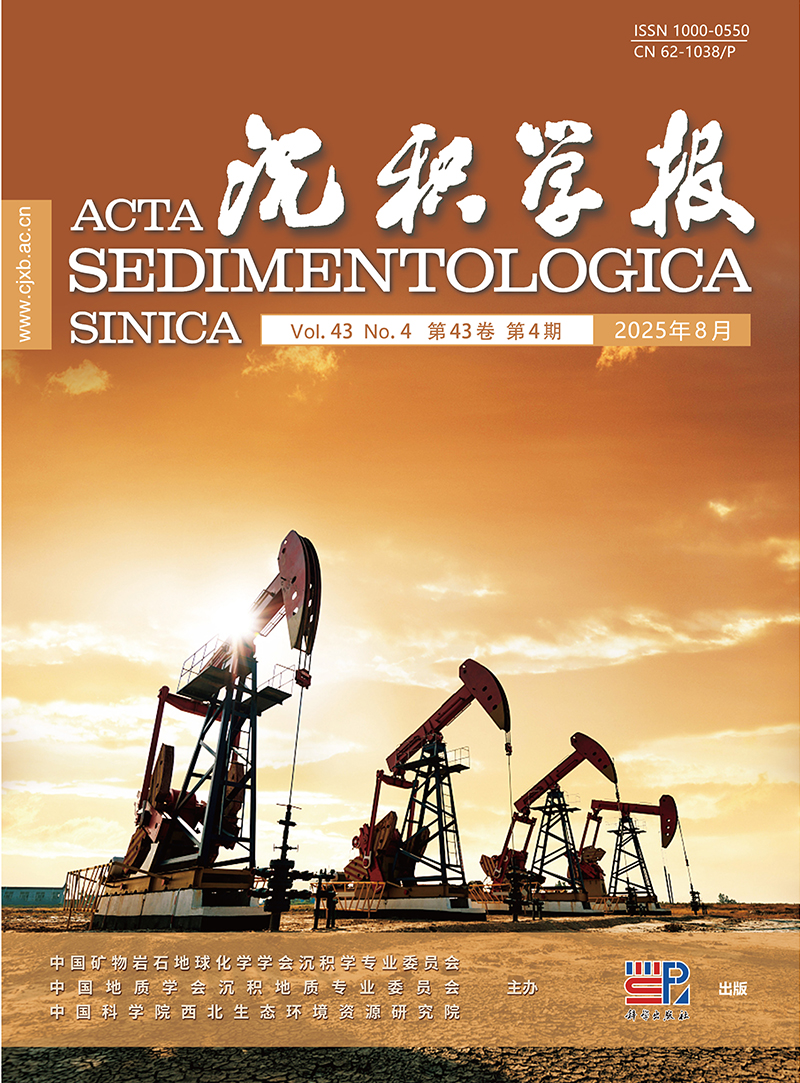




















 DownLoad:
DownLoad:

